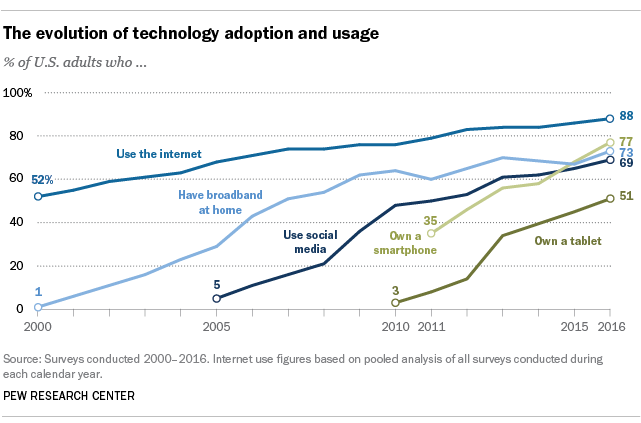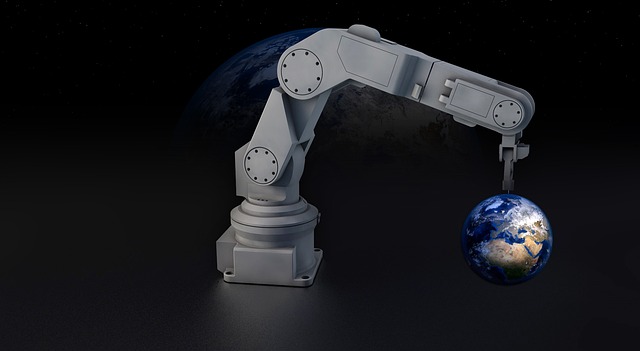You’ve probably heard it before – if your business is not on top of digital transformation, then you’re in danger of being left behind.
Digital transformation, along with associated technology changes such as automation, are hot topics in the news today. In fact, go back a couple of centuries and you’ll find that the impacts of modern technology on human workers have been subject to critical debate for a long time.
Lord Byron, in a speech to his governing peers about the textile workers who protested the machinery taking over their craft stated:
“The rejected workmen, in the blindness of their ignorance, instead of rejoicing at these improvements in arts so beneficial to mankind, conceived themselves to be sacrificed to improvements in mechanism.”
Essentially, we’re seeing similar impacts through digital transformation today, although of course, there are also a myriad of positive impacts. How is digital transformation affecting the way we work? Let’s explore:
Digital transformation is inevitable
When you look back at the various points in history where contemporary technology has changed the way work is done, you can see that really, it’s a continuous cycle in each generation. We innovate, and we look for ways to use that new innovation to make our work more efficient or effective.
In the case of digital, as we have outlined previously, the introduction of digital technologies is not about internal business efficiencies alone. Today, it’s part of customer expectation that companies should be up-to-date and offer them the various features that digital technology can provide. Even when the introduction of that technology for the customer renders a job that used to be done by a human obsolete…
Of course, the new technology doesn’t always mean automatic redundancy for humans – sometimes it means that skill re-orientation is required, for example, moving from a paper-based system to something that is cloud-based. (Although in this case, anyone who was working as a filing clerk probably no longer has that job role!)
As a whole, workplaces are becoming digitized as everyday life outside of work is too. In the US alone, recent data shows that almost 90% of people are online, while 77% own a smartphone. While less prevalent than smartphones, 51% of people own a tablet. It is little wonder that with such widespread dominance of these technologies, people expect to be able to use them through the companies they seek products and services from.

Digital transformation: The good
The latest trends in digital transformation acknowledge how customers expect to interact with technology, but also how people work, and connect with their work environments.
In many respects, you could say that digital transformation opens up more possibilities for both workers and their employers. For example, without the aid of digital technology, how would the many companies now offering remote-based work operate? How would a large number of independent contractors or freelancers out there facilitate their jobs?
Last year, at least 43% of Americans spent at least some time working remotely, while freelancers now make up at least 35% of the U.S. workforce. Admittedly, there has always been some who have been able to work remotely, but the numbers have exploded since digital technology has been able to facilitate their work.
For workers, this has meant some viable options beyond the classic 9 – 5. People who may have traditionally been shut out of the workforce, or had a difficult time finding suitable work (such as stay-at-home parents), now have a way forward enabled by digital technology.
For businesses, this has meant that they can potentially look further afield for the best team members, or even drastically reduce operating expenses where they no longer need to work in co-located offices. Many businesses have also reduced the cost of their wage and salary liability by engaging workers in areas where it costs them a lot less.
In other applications, digital technology is being used to:
- Keep in touch with and measure sentiment among employees. IBM is a great example, measuring sentiment across a global workforce of 380,000 employees. They did this via their own internal social media platform, Connections.
- Engage more fully with customers. For example, companies can gather feedback, conduct market research and test out new products more easily than ever. Digital technology means that we now use more channels to engage, rather than traditional mediums like telephone or letters.
- Automate many job functions, even some customer interactions. For example, the use of bots and AI with its machine learning technology has become more prevalent. This can allow companies to become more efficient where the machine can respond more quickly than a human operator. It has also meant that they can focus human tasks on the things that are most important for them to be doing.
- Create intelligent processes which make it possible to streamline and make decisions very quickly. You could take investment software as an example – while traditionally there was always a lag between what markets were doing and what you were seeing, now companies and individuals have real-time data. In some cases, they can even automate decision-making around set parameters.
- Track rapid, “fail fast” iteration. For example, digital technology enables companies to test pricing very quickly and efficiently, then make any changes just as quickly. Prior to digital, this may have taken weeks of monitoring results.
The overall key is, where there is a distinct, repeatable process, that can be ripe for digital transformation, giving businesses the opportunity to streamline and to remain competitive. There have often been fears expressed that “the robots are taking over” and that pretty soon, there won’t be anything left for humans to do, however, many experts argue this is not the case.
Take the following example, from a recent presentation by Google’s Hal Varian:
“So let’s take a job like gardener. We don’t think of gardener as being a really high-skilled, super high-skilled job. But it’s a very varied job. There’s lots of different things that gardeners do. They trim the trees. They cut the grass. They plant flowers. They do this, they do that; all sorts of activities. And automating any one of those tasks you could do with several million dollars and several years of research. But automating all of them would be extremely difficult.”
Automation is suited to routine environments, but not for those with a lot of variation. There’s also the question, will AI ever be advanced enough to be creative? Hmm, not at this point…

Digital transformation: The bad
The most vocally expressed negative point about digital transformation is the potential for machinery to replace human workers at rates we haven’t seen before. The growth of Artificial Intelligence (AI), makes more tasks possible as robots can be trained via machine learning to make decisions within certain parameters.
Will self-driving cars put cab drivers out of their jobs? What about drones that deliver packages, or manufacturing robots that are so advanced, they’re even able to train new robots to work in our factories?
The bottom-line fear is that digital technology might take the jobs of millions of people in a short space of time. What then happens to their economic well-being and that of countries as a whole? Many ideas are being batted around, including talk of universal allowances or imposing a “robot tax” on the use of robotics in place of humans, to ensure that the taxes which otherwise would have been paid still come in.
Some of the other changes brought about by digital technology may also be seen in a negative light, depending on whose perspective you look from. Offshoring of knowledge work (think of tasks like coding and programming), has been facilitated by advances in how we communicate and can give companies access to cheaper labor. However, this has often been at the expense of local workers. Companies such as big banks have “restructured” in order to offshore functions such as call centers or IT teams, laying off thousands of locals.
To finish with one final point to the negative, privacy concerns have also been a big deal when it comes to digital transformation. If everything is connected and companies have access to unprecedented levels of data on employees and customers, how do we ensure that privacy is respected?
Final thoughts
Digital transformation is necessary for businesses that want to remain competitive, but it is changing the landscape of work as we know it.
New technologies are enabling capabilities and streamlining at more advanced levels for businesses, changing the relationship with how we interact with our workplaces and the tasks we need to perform.
On the other hand, technologies are displacing human workers. At a recent London event, historian and author, Yuval Noah Harari described the possibility of a future “global useless class”, brought about by automation. “Disruptive technologies, which have helped bring enormous progress, could be disastrous if they get out of hand.”
Digital transformation is encompassing and comes with both positives and negatives – what will the future of work hold?
Koombea helps companies to stay at the edge of digital transformation through savvy development. Talk to us about how we can help you today.
